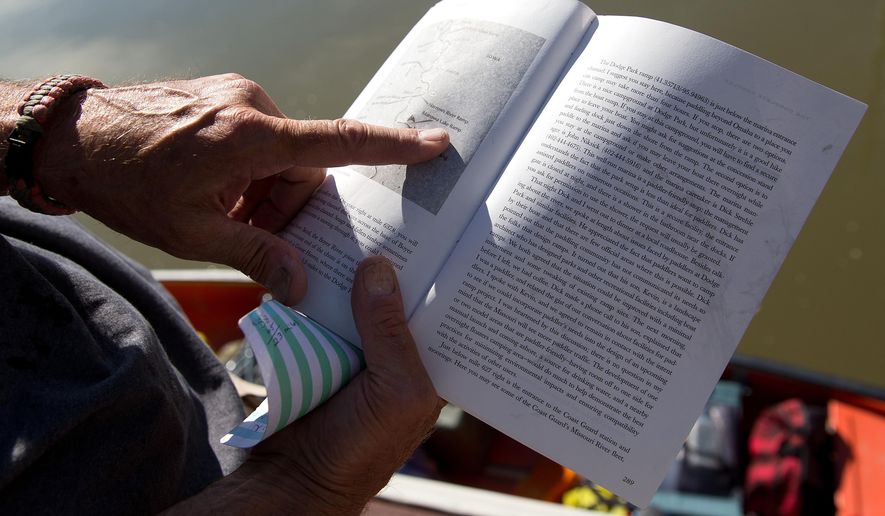OMAHA, Neb. (AP) - After paddling the Missouri River through three and a half states, Dave Starkey tied up his canoe at the small marina by Lewis and Clark Landing near downtown Omaha.
He ambled into the Storz Trophy Room on a Sunday afternoon this month for his first meal in weeks not prepared on a river bank.
He asked the bartender to call restaurant owner Tom Markel, the Omaha World-Herald (https://bit.ly/1GGB0zl ) reported.
“?’This is probably going to be the strangest phone call you’ve ever gotten,’?” Markel said, recalling his conversation with Starkey. “?’But I’ve been paddling the Missouri River for two months, have been through storms, almost died and just wanted to grab a bite to eat, and if you know of anywhere I should stay.’ “
Starkey ate a full meal and dessert and drank local beers, all on the house. Markel eventually came to the restaurant, helped Starkey, 58, pull his canoe and gear from the river and stored the canoe by the kitchen.
Starkey just wanted a couple days of rest in Omaha on the 2,321-mile trek from the river’s source in western Montana to the St. Louis Arch.
Officials at the Jefferson National Expansion Memorial at The Arch said they hear of typically one or two people per year who paddle the entire distance, though no records are kept.
Starkey has met people throughout his journey, not encountering anyone who hasn’t been helpful.
But he felt especially welcomed in Omaha, where one of the Storz workers drove Starkey to a nearby motel where he rested for two nights, mostly relaxing in his room watching Fox News and black and white movies. He walked a mile to eat fast food on Monday, greasy food he thought would help after losing 40 pounds since he began his trek in early May.
Starkey, normally clean-shaven, also has a gray, grizzly beard, which he hasn’t trimmed since he left his home in Fults, Illinois.
He left a razor with his wife and two children in Illinois. His third child is in the Navy aboard a submarine.
“It’s funny, he’s on the most advanced vessel in the world, while I’m on the most primitive,” Starkey said. “But he thinks it’s really cool and wants to do this one day.”
Starkey said his wife wasn’t too happy when he decided to set out on this expedition, while his kids mostly thought it was cool. He calls his family when he can on a cellphone he dusted off specifically for the trip. Starkey doesn’t use a cellphone at home - he’s mostly sick of technology. He spent most of his professional career working as an intelligence officer with the Department of Defense in St. Louis.
“I always worked in a room surrounded by technology with no windows,” Starkey said. “After I retired three years ago, I just wanted to get away from it all.”
He’s a big fan of Lewis and Clark, reading their journals and camping along the river in the same spots they did in their expedition to explore the waterway to the west. Starkey often keeps a small bottle of whiskey to sip after a 30-mile trek on the river, just like Lewis and Clark did.
Starkey also wanted the adventure and a challenge. He got what he wanted, encountering heavy storms and winds over 80 mph. When paddling through lakes in Montana and North Dakota the waves were roughly 4 feet high, and Starkey was so fearful he prayed.
The water was chilly, and there was no one around to rescue him if the boat tipped. Fortunately, his canoe never capsized, and he stopped to set up camp on the river bank early if the weather appeared ominous.
“My advice to anyone who wants to do this: Don’t do it,” Starkey said. “That usually gets a laugh out of people. But, no, in all seriousness if you’re considering it, do your homework and your research. You need the right gear.”
Starkey’s gear includes a 5-gallon water jug, dry food, three shirts, two pairs of pants, two pairs of shoes, three pairs of socks and three pairs of underwear. He also has a knife, boat stabilizers, camping equipment and a handgun that he hasn’t had to use.
He’s prepared for most things that come his way. He has experience in a canoe, though he wishes he had put in more practice paddling before driving his canoe and gear up to Montana in May. Starkey has learned to navigate the waters on the fly, avoiding most sandbars but chastising himself if he doesn’t.
Starkey hopes the toughest conditions are behind him but understands he has entered a phase that presents other possible hazards.
Once he started seeing big, bushy trees hanging over the brown river, he realized the waterway had changed. South of Sioux City, the river is more commercialized. That’s especially so in Omaha, where it’s rare to see a kayak or canoe - mostly boats or barges.
The wakes could knock his boat over and jeopardize his journey, so Starkey always has his head on a swivel looking for possible dangers. He expects to arrive in St. Louis at the end of August.
But as the river flowed calmly Tuesday morning, Starkey paddled away from Lewis and Clark Landing and caught the current.
Mike Simon of Omaha was enjoying a day off sitting on a bench by the riverfront. He saw Starkey paddling by. Simon stood up and ran to the railing overlooking the water.
“I don’t know that I’ve ever seen a canoe in there,” Simon said, taking pictures with his cellphone.
“That’s amazing.”
___
Information from: Omaha World-Herald, https://www.omaha.com




Please read our comment policy before commenting.